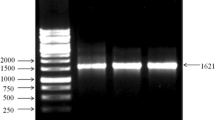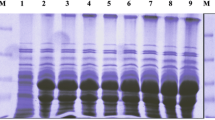Abstract
The Vegetative insecticidal Vip3A proteins display a wide range of insecticidal spectrum against several agricultural insect pests. The fact that the expression of vip3 genes occurs only during the vegetative growth phase of Bacillus thuringiensis is a limiting factor in term of production level. Therefore, extending the synthesis of the Vip proteins to the sporulation phase is a good alternative to reach high levels of toxin synthesis. In this study, we have demonstrated that the maximal production of the secreted Vip3LB (also called Vip3Aa16) during the growth of the wild-type strain B. thuringiensis BUPM 95 is reached at the end of the vegetative growth phase, and that the protein remains relatively stable in the culture supernatant during the late sporulation stages. The vip3LB gene was cloned and expressed under the control of the sporulation dependant promoters BtI and BtII in B. thuringiensis BUPM 106 (Vip3−) and BUPM 95 (Vip3+) strains. The examination of the culture supernatants during the sporulation phase evidenced the synthesis of Vip3LB and its toxicity against the second-instars larvae of the Lepidopteron insect Spodoptera littoralis for the recombinant BUPM 106. Moreover, there was an increase of the Vip3LB synthesis level and an enhancement of the oral toxicity for the recombinant BUPM 95 resulting from the expression of the vip3LB gene during both the vegetative and sporulation phases and the relative stability of the Vip3LB protein.



Similar content being viewed by others
References
Abdelkefi-Mesrati L, Tounsi S, Jaoua S (2005) Characterization of a novel vip3-type gene from Bacillus thuringiensis and evidence of its presence on a large plasmid. FEMS Microbiol Lett 244:353–358
Abdelkefi-Mesrati L, Tounsi S, Kamoun F, Jaoua S (2005) Identification of a promoter for the vegetative insecticidal protein-encoding gene vip3LB from Bacillus thuringiensis. FEMS Microbiol Lett 247:101–104
Arantes O, Lereclus D (1991) Construction of cloning vectors for Bacillus thuringiensis. Gene 108:115–119
Arora N, Selvapandiyan A, Agrawal N, Bhatnagar RK (2003) Relocating expression of vegetative insecticidal protein into mother cell of Bacillus thuringiensis. Biochem Biophys Res Commun 310:158–162
Bibilos M, RE Andrews Jr (1988) Inhibition of Bacillus thuringiensis proteases and their effects on crystal toxin proteins and cell free translations. Can J Microbiol 34:740–742
Brown KL, Whiteley HR (1990) Isolation of the second Bacillus thuringiensis RNA polymerase that transcribes from a crystal protein gene promoter. J Bacteriol 172:6682–6688
Crickmore N, Zeigler DR, Schnepf E, Van Rie J, Lereclus D, Baum J, Bravo A, Dean DH (2011) Bacillus thuringiensis toxin nomenclature. http://www.lifesci.sussex.ac.uk/Home/Neil_Crickmore/Bt/vip.html
Estruch J, Warren GW, Mullins MA, Nye GJ, Craig JA, Koziel HG (1996) Vip3A, a novel Bacillus thuringiensis vegetative insecticidal protein with a wide spectrum of activities against lepidopteran insects. Proc Natl Acad Sci USA 93:5389–5394
Laemmli UK (1970) Cleavage of structural proteins during the assembly of the head of bacteriophage T4. Nature (Lond) 227:680–685
Lee MK, Walters FS, Hart H, Palekar N, Chen JS (2003) The mode of action of the Bacillus thuringiensis vegetative insecticidal protein VIP3A differs from that of Cry1Ab δ-endotoxin. Appl Environ Microbiol 69:4648–4657
Lereclus D, Arantes O, Chaufaux J, Lecadet MM (1989) Transformation and expression of a cloned δ-endotoxin gene in Bacillus thuringiensis. FEMS Microbiol Lett 60:211–218
Liu CM, Tzeng YM (2000) Characterization study of the sporulation kinetics of Bacillus thuringiensis. Biotechnol Bioeng 68:11–17
MacIntosh SC, Stone TB, Sims SR, Hunst PL, Greenplate JT, Marrone PG, Perlak FJ, Fischhoff DA, Fuchs RL (1990) Specificity and efficacy of purified Bacillus thuringiensis proteins against agronomically important insects. J Invertebr Pathol 56:258–266
Moar WJ, Pusztai-Carey M, Van Faassen H, Bosch D, Frutos R, Rang C, Luo K, Adang MJ (1995) Development of Bacillus thuringiensis CryIC resistance by Spodoptera exigua (Hubner) (Lepidoptera: Noctuidae). Appl Environ Microbiol 61:2086–2092
Poitout Bues (1970) Elevage de plusieurs espèces de lépidoptères noctuidae sur milieu artificiel riche et sur milieu artificiel simplifié. Ann Zool Ecol Anim 2:79–91
Rang C, Gil P, Neisner N, Van Rie J, Frutos R (2005) Novel Vip3-related protein from Bacillus thuringiensis. Appl Environ Microbiol 71:6276–6281
Sambrook J, Fritsch EF, Maniatis T (1989) Molecular cloning. A laboratory manual, 2nd edn. ColdSpring Harbor Laboratory, Cold Spring Harbor, NY
Schnepf E, Crickmore N, Van Rie J, Lereclus D, Baum J, Feitelson J, Ziegler DR, Dean DH (1998) Bacillus thuringiensis and its pesticidal crystal proteins. Microbiol Mol Biol Rev 62:775–806
Schurter W, Geiser M, Mathé D (1989) Efficient transformation of Bacillus thuringiensis and B. cereus via electroporation: transformation of acrystalliferous strains with a cloned delta-endotoxin gene. Mol Gen Genet 218:177–181
Sedlak M, Walter T, Aronson A (2000) Regulation by overlapping promoters of the rate of synthesis and deposition into crystalline inclusions of Bacillus thuringiensis delta-endotoxins. J Bacteriol 182:734–741
Song R, Peng D, Yu Z, Sun M (2008) Carboxy-terminal half of Cry1C can help vegetative insecticidal protein to form inclusion bodies in the mother cell of Bacillus thuringiensis. Appl Microbiol Biotechnol 80:647–654
Tounsi S, Zouari N, Jaoua S (2003) Cloning and study of the expression of a novel cry1Ia-type gene from Bacillus thuringiensis subsp. kurstaki. J Appl Microbiol 95:23–28
Wong HC, Schnepf HE, Whiteley HR (1983) Transcriptional and translational start sites for the Bacillus thuringiensis crystal protein gene. J Biol Chem 258:1960–1967
Acknowledgment
We are grateful to Dr. L. Abdelkefi-Mesrati for providing the polyclonal antibody against Vip3LB. This study was supported by grants from the Tunisian « Ministère de l’Enseignement Supérieur et de la Recherche Scientifique (MESRS) » .
Author information
Authors and Affiliations
Corresponding author
Rights and permissions
About this article
Cite this article
Sellami, S., Jamoussi, K., Dabbeche, E. et al. Increase of the Bacillus thuringiensis Secreted Toxicity Against Lepidopteron Larvae by Homologous Expression of the vip3LB Gene During Sporulation Stage. Curr Microbiol 63, 289–294 (2011). https://doi.org/10.1007/s00284-011-9976-3
Received:
Accepted:
Published:
Issue Date:
DOI: https://doi.org/10.1007/s00284-011-9976-3




